
Wagyu F1 calves on AA Co’s Avon Downs station on the Barkly Tableland
BALANCING selection for polledness with other traits and maintaining genetic diversity within a herd is challenging. This means it is essential that the implications of integrating the polled trait into an existing beef breeding program be considered, as accurately as possible.
To this end, a new genetic predictive tool called Digital Twin technology is being used to accurately predict outcomes in the Australian Agricultural Co’s efforts to genetically dehorn its composite and Wagyu breeding herds.
Stakeholders heard about the new Digital Twin technology during a recent Beef Connect* webinar, hosted by FutureBeef and Beef Central.
In a collaboration between MLA, AA Co and the University of Queensland, the Digital Twin project has created a highly accurate prediction of AA Co’s seedstock breeding program.
The predictive tool allows for the optimisation of the breeding program to find the most effective pathway to a polled herd, the audience heard.
The key part of the digital twin is the use of the genomic simulation software which uses real genotypes to simulate offspring. This allows realistic breeding values and inbreeding to be calculated for multiple generations.
The project has sought to answer questions such as:
- What is the optimal blend of natural service, artificial insemination and embryo transfer in a breeding program?
- How much selection pressure can be applied for polled without compromising genetic gain for other traits?

James Copley
AA Co’s quantitative geneticist Dr James Copley told the webinar there were some particular challenges in selection for polled cattle, and especially so in Wagyu a breed (in Australia, at least) with minimal genetic diversity and a low incidence of polledness.
“And in trying to select for polls, we obviously have to balance that selection pressure with other production traits, while managing the level of inbreeding,” Dr Copley said.
One way of managing and modelling this was to develop what is called a ‘digital twin’ – a term borrowed from engineering, representing a precise simulated version of a beef breeding program. The Digital twin is designed to predict the outcome before execution/joining, measuring both genetic gain and inbreeding.
“It means you can predict a breeding outcome quite accurately, before the bulls are put out,” Dr Copley said.
In AA Co’s case the Digital Twin tool has been used to measure genetic gain for polledness, for production traits, and the level of potential inbreeding.
The ‘engine room’ of the Digital Twin is genomic simulation software developed by a team led by Kira Villiers at University of Queensland. The solution takes input from real genotypes (in the case of AA Co’s Wagyu herd, some 2500 animals), and ‘crosses’ them to generate a simulated offspring with a realistic genotype.
“With that simulated, but realistic genotype, it is then possible to calculate breeding values for those simulated individuals – as simulated offspring. And then the simulated offspring can continue to be crossed for multiple generations,” Dr Copley said.
The technique has been used already for crops, as well as barramundi, but this is the first time it has been demonstrated in beef cattle.
Even prior to the development of the Digital Twin, considerable legwork had happened taking the many nuances of a breeding program into account, such as issues like weaning rates, joining rates, culling rates, mortality rates, and selection intensity (how many sires are used); as well as in the case of an IVF breeding program, how many donors are selected, and how many embryos are likely to be harvested from each.
It was important to know all of those parameters before the Digital Twin can be used, Dr Copley said.
The other inputs needed for the Digital Twin process include parental genotypes and SNP effects for desirable selection traits (in the case of this Wagyu project – marbling, feedlot days, 400-day weight, feed intake and mature cow weight, combined into a selection index. These are used to balance against the poll trait.
SNP effects for each of those traits have been developed within AA Co’s internal genetic evaluation process.
“Once we have all that information, what we aim to do is answer the key question: What is the optimal combination of selection pressure and breeding programs to achieve a polled herd, while balancing genetic gain for other traits and balancing for inbreeding,” Dr Copley said.
There were several components to this:
- Testing different poll ‘weights’ (different levels of selection pressure for polledness). This ranged from zero percent (not considering polledness at all, but using only the selection index for other traits) up to 100pc (only considering polledness, and not the selection index at all)
- Different breeding techniques, ranging from natural service to artificial insemination and IVF/embryo transfer.
Natural service
The graph below plots the Digital Twin’s forecast for genetic gain using natural service in AA Co’s Wagyu over a ten year period:
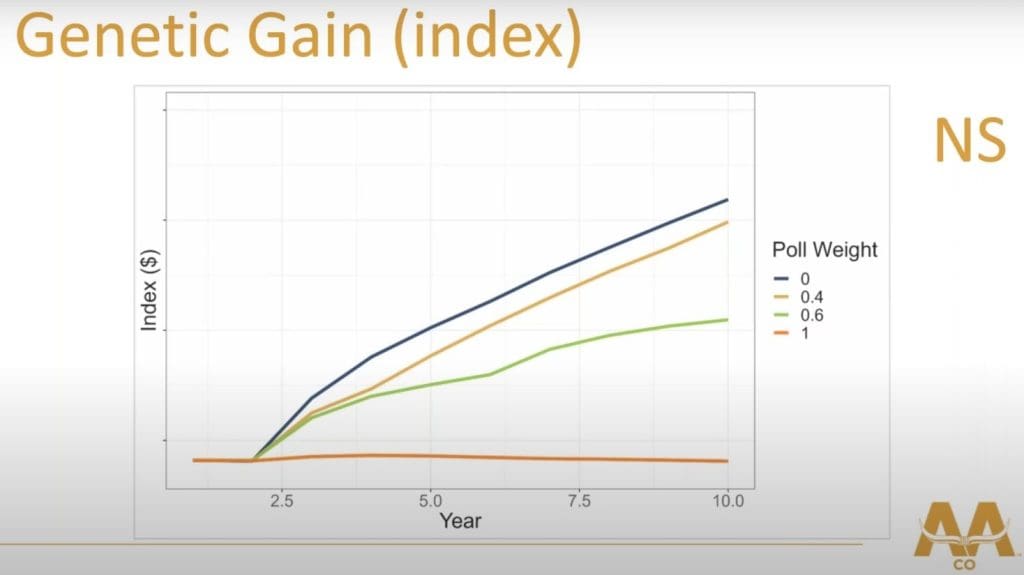
The orange line above shows what happens if 100pc weight is put on polledness (no index), showing zero index gain. The blue line shows what happens when zero pressure is put on polledness, which maximises gains for the selection index of other traits listed above. Neither of those two outcomes are surprising, but the two interesting lines are the brown (40pc) and green (60pc) weighting on polledness.
A similar plot line applying AI as the breeding method shows slightly greater gain for the selection index over ten years – simply a function of more coverage of the best sires.
Another graph, published below, showed a similar, but more intense improvement for IVF/ET (natural service shadow lines for comparison).
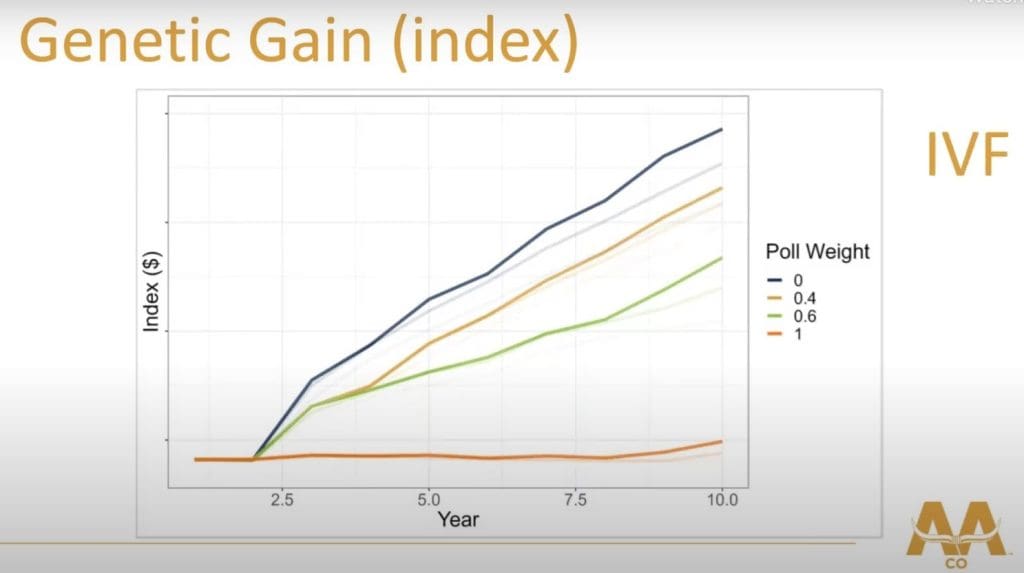
The key takeaways from the plot graphs are that there is a real opportunity cost of only selecting on polledness, with a lot of genetic gain for other important traits (in Wagyu’s case, marbling and carcase traits) being sacrificed if only selecting for polledness, Dr Copley said.
A similar plot set out in the graph below shows genetic gain for polledness over ten years, using natural mating (homozygous and heterozygous polls combined). It shows that over a ten year period, and starting from a very low base, it is possible to get to close to 100pc polled animals. Importantly, it shows that there is little real difference in the rate of gain in achieving 100pc polled animals between a 60pc weighting (green line) and 100pc weighting (orange line).
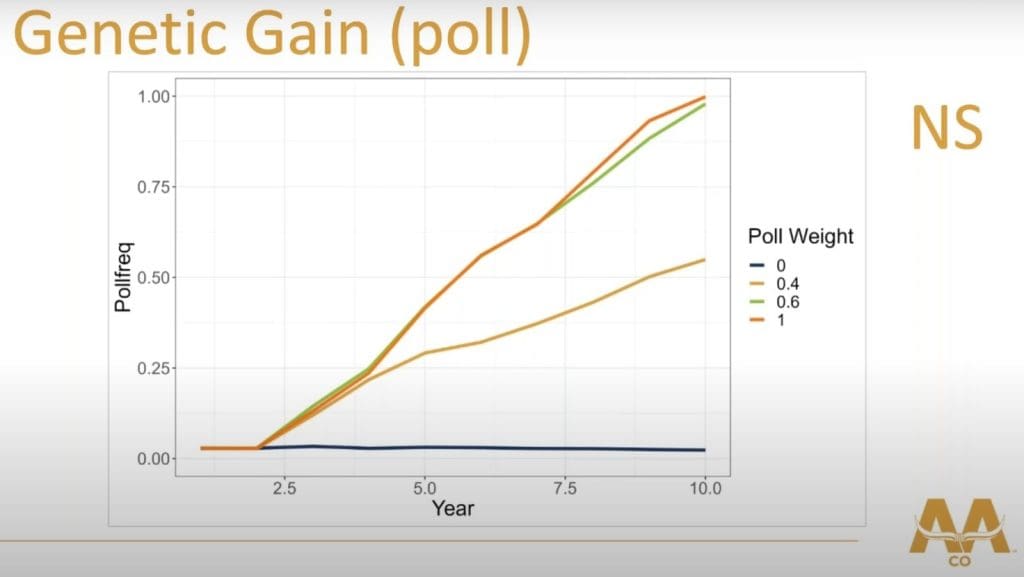
“That appears to be a function of the fact that there just aren’t enough polled animals available to select for 100pc weighting,” Dr Copley said. “But selecting for 60pc weighting, we’re still going to get reasonable gain in the selection index based on desirable traits, while also being close to maximum rate of gain for polledness.”
A similar trend is evident for an AI-based breeding program (albeit getting to 100pc polled a little faster, 8-9 years), and for IVF (graph below) a little faster again.
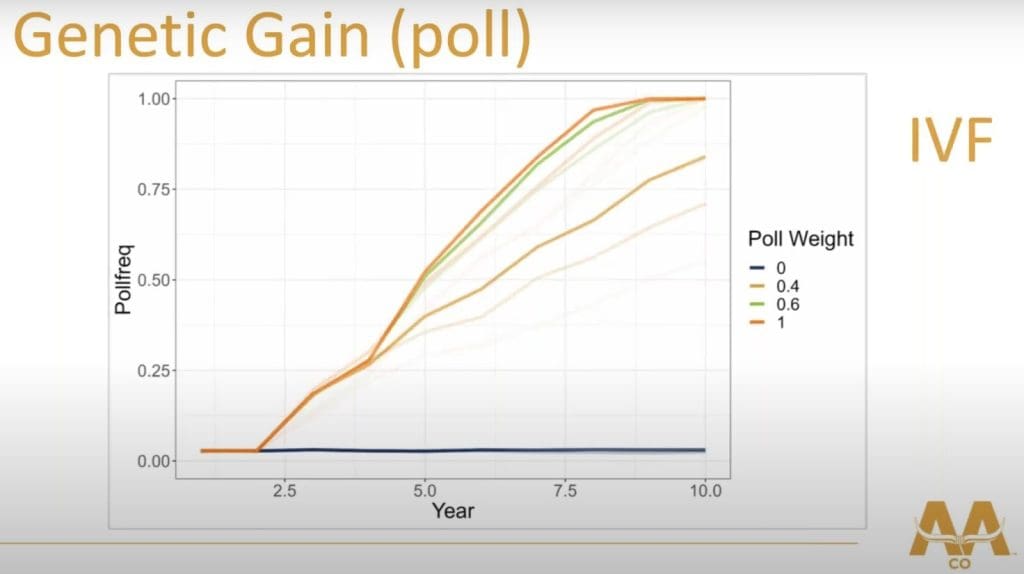
In this particular example, the key takeaway is that there is no real point in exceeding a 60pc weighting on selection for polledness – it was not going to get to the objective (100pc polled herd) any faster, and to do otherwise was simply going to sacrifice genetic gain for other traits, Dr Copley said.
Inbreeding
In determining the level of inbreeding involved, the higher the value on the Y axis in the graph below, the higher the level of inbreeding.
For the natural service breeding program, there is not a large amount of difference, regardless of which polled weighing is applied.
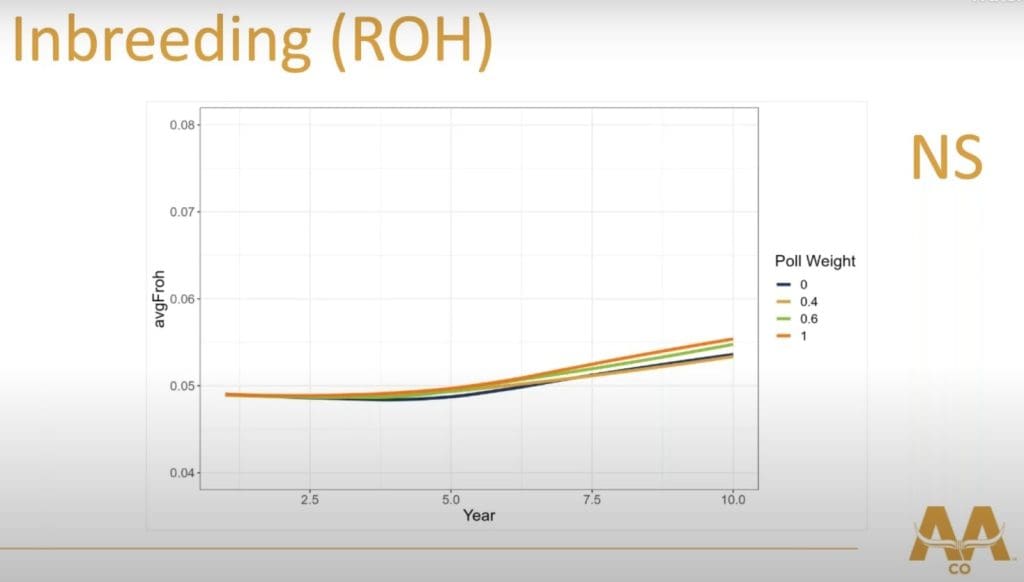
But what does make a difference is the choice of breeding program. In both the AI and IVF forecasts made by the Digital Twin calculator in the graph below, inbreeding is higher, and significantly higher when using AI and IVF programs, respectively.
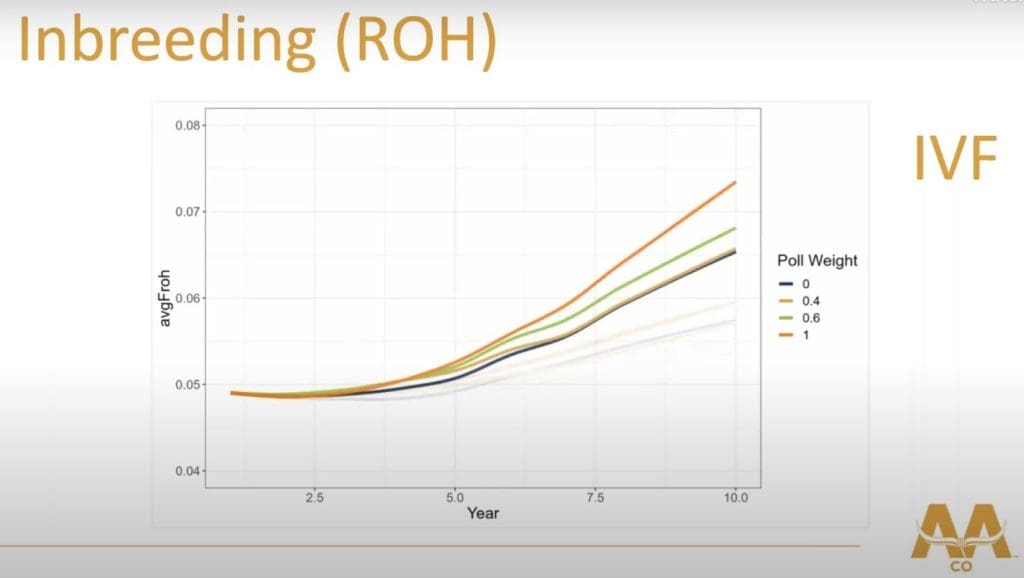
In the graph above, the level of inbreeding in the orange line (100pc poll weight) is above 7pc – getting towards the level where one starts worrying about inbreeding depression and expression of genetic defects, Dr Copley said.
“While IVF programs do get to the objective faster, you may have to manage the levels of inbreeding,” he said.
“It’s been said before: the harder or faster you go in breeding pressure, the more careful you have to be. IVF is great technology, and it can maximise rate of gain, but inbreeding does need to be taken into account.”
Adaptable to small herds
Dr Copley said the use of the Digital Twin technology was not only applicable to large herds like AA Co’s Poll Wagyu breeding project, but also to smaller herds.
“The software and the code that’s written around it can be used to model other scenarios,” he said.
“For example what if you only have a small herd, and are only using IVF? Can you get a high rate of genetic gain, even in a small herd, and what is the inbreeding impact likely to be?
Taking a 60pc weighing on polled selection as a baseline, a small herd scenario (orange, somewhat jagged line in the graph below) shows net gain over ten years for the Wagyu selection index.
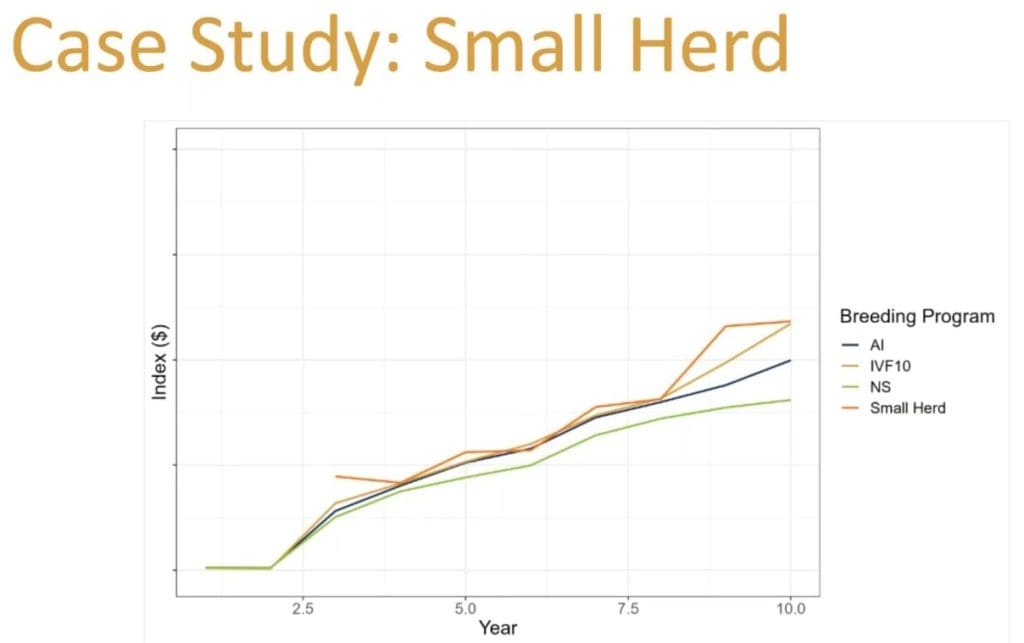
“With its higher selection intensity, it does have a higher rate of gain (even higher than the IVF scenario modelled for AA Co) – but not significantly higher,” Dr Copley said.
The same applied for polledness in a small herd, getting to 100pc polledness a little faster, but not significantly so – and it came at a significant risk of high inbreeding.
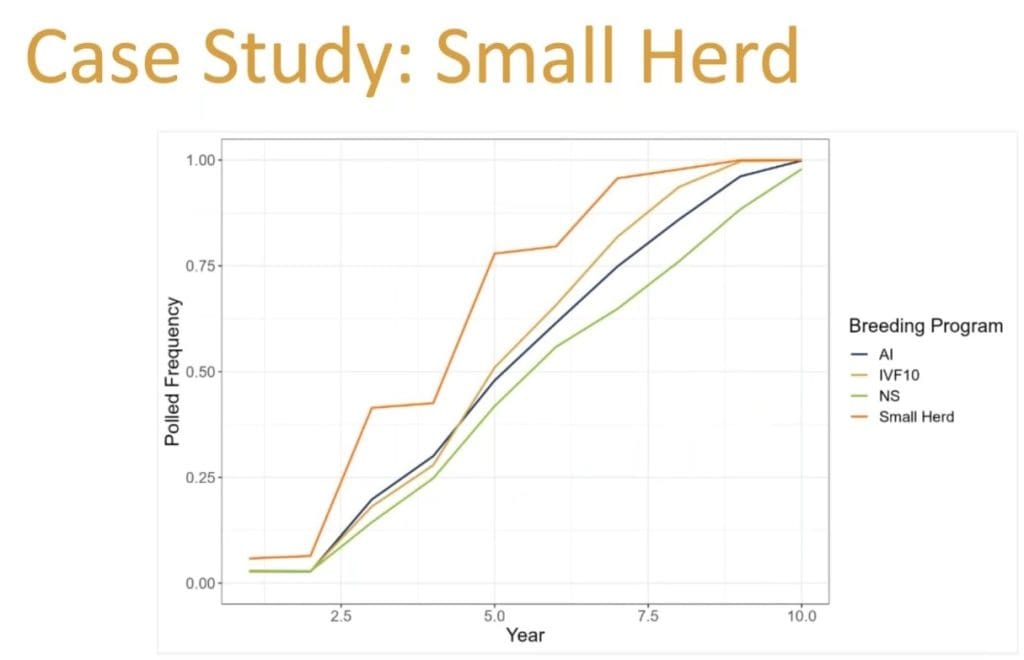
In the graph below, the small herd scenario approaches 17.5pc inbreeding – definitely in the realm of high risk for genetic defects and inbreeding depression.
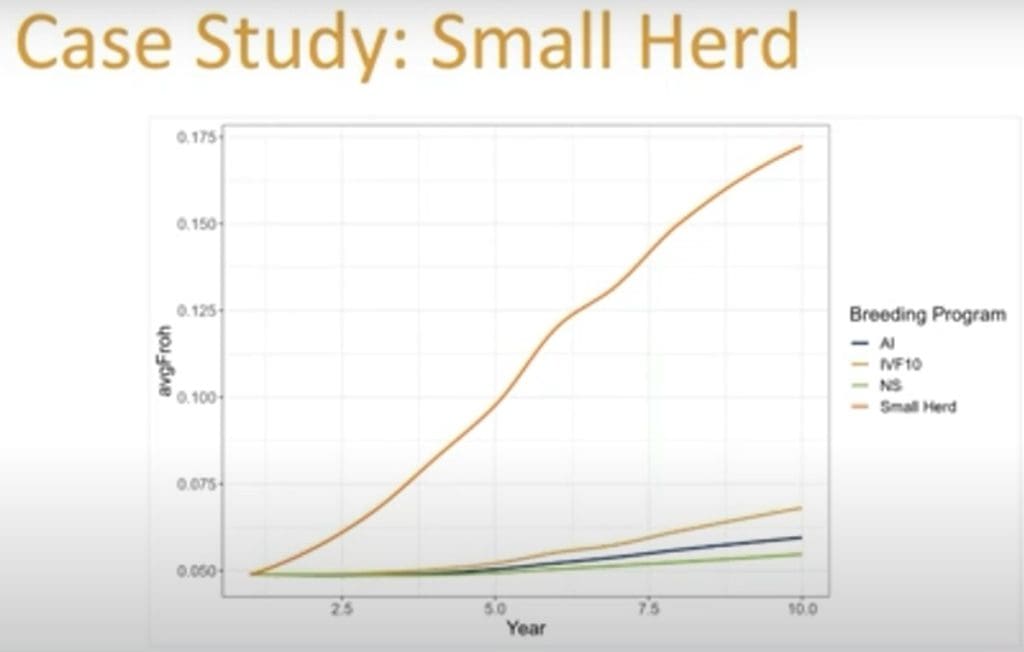
Dr Copley said there were some elements of the small herd example that were potentially a little unrealistic. The model was assuming sires and donors are drawn only from within the herd (no outside animals, which in reality a small breeder would not do), but it demonstrates that external genetics would be essential.
Where to now for Digital Twin technology?
In summary, the Digital Twin technology clearly showed that selecting for a polled Wagyu herd for AA Co within ten years is definitely feasible. However while IVF may be a great tool to get there faster, it potentially results in higher rates of inbreeding.
For the example of AA Co’s Wagyu herd, selection pressure beyond 60pc on polledness is not really worth it – only compromising the rate of genetic gain for other production traits, the tool showed.
The future direction for the Digital Twin tool over the next two years of development is likely to include:
- Expanding into commercial herds
- Tracking recessive genetic conditions
- Integrating better management of inbreeding by using Matecell selection and allocation, and
- Developing a dashboard version of the technology.
 * Beef Connect webinars are a collaboration between FutureBeef (state ag departments in Qld, NT and northern WA) and Beef Central.
* Beef Connect webinars are a collaboration between FutureBeef (state ag departments in Qld, NT and northern WA) and Beef Central.
